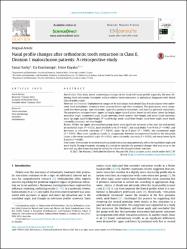| dc.contributor.author | Sadry, Sanaz | |
| dc.contributor.author | Eusmanaga, Ela | |
| dc.contributor.author | Kayalar, Emre | |
| dc.date.accessioned | 2024-04-16T13:13:12Z | |
| dc.date.available | 2024-04-16T13:13:12Z | |
| dc.date.issued | 2024 | en_US |
| dc.identifier.citation | Sadry, S., Eusmanaga, E., & Kayalar, E. (2024). Nasal profile changes after orthodontic tooth extraction in Class II, Division 1 malocclusion patients: A retrospective study. JOURNAL OF STOMATOLOGY ORAL AND MAXILLOFACIAL SURGERY, 125(5), 1-9. https://doi.org/10.1016/j.jormas.2023.101748 | en_US |
| dc.identifier.issn | 2468-7855 | |
| dc.identifier.uri | https://hdl.handle.net/20.500.12900/335 | |
| dc.description.abstract | Introduction: This study aimed to investigate changes in the facial soft -tissue profile, especially the nose, following fixed orthodontic treatment, with or without tooth extraction, in individuals diagnosed with dental Class II malocclusion. Materials and methods: Cephalometric images of 81 individuals with dental Class II malocclusion who underwent fixed orthodontic treatment were assessed before and after treatment. The participants were categorized into three groups: non -extraction; upper first premolar extraction; and four first premolar extractions. The parameters measured were: upper lip height, upper lip to E -plane, lower lip to E -plane, lower lip height, nasolabial angle, nasomental angle, facial convexity, lower anterior face height, soft -tissue facial convexity, nasal tip angle, nasal bridge length, N0 -nasal bridge point, nasal bone length, nasal bone angle, nasal depth, columella convexity, and nose height. Results: Within the upper two extraction group, there were significant increases at the start and end periods in nasolabial angle (P = 0.023), nasal depth Pr to Ac (P = 0.027), and nasal depth Pr to N-Prn (P = 0.040); and decreases in columella convexity (P = 0.010), upper lip to E -plane (P = 0.009), and nasomental angle (P = 0.009). There were significant results in comparisons between measurements based on the extraction status in the mean nasolabial angle (P = 0.011), mean columella convexity (P = 0.028), and mean lower lip to E -plane (P = 0.045). Conclusion: Orthodontic treatment involving tooth extraction may potentially affect the nasolabial angle and nasal depth. During treatment planning, it is crucial to consider the potential changes that may occur to the nose and any alterations that may be needed to achieve the desired esthetic outcome. (c) 2023 The Author(s). Published by Elsevier Masson SAS. This is an open access article under the CC BY license | en_US |
| dc.language.iso | eng | en_US |
| dc.publisher | ELSEVIER | en_US |
| dc.relation.isversionof | 10.1016/j.jormas.2023.101748 | en_US |
| dc.rights | info:eu-repo/semantics/openAccess | en_US |
| dc.subject | Diş çekimi | en_US |
| dc.subject | Tooth extraction | en_US |
| dc.subject | Burun morfolojisi | en_US |
| dc.subject | Nose morphology | en_US |
| dc.subject | Estetik | en_US |
| dc.subject | Aesthetics | en_US |
| dc.subject | Sefalometri | en_US |
| dc.subject | Cephalometry | en_US |
| dc.title | Nasal profile changes after orthodontic tooth extraction in Class II, Division 1 malocclusion patients: A retrospective study | en_US |
| dc.type | article | en_US |
| dc.department | İstanbul Atlas Üniversitesi, Diş Hekimliği Fakültesi | en_US |
| dc.authorid | https://orcid.org/0000-0002-2160-0908 | en_US |
| dc.contributor.institutionauthor | Sadry, Sanaz | |
| dc.identifier.volume | 125 | en_US |
| dc.identifier.issue | 5 | en_US |
| dc.identifier.startpage | 1 | en_US |
| dc.identifier.endpage | 9 | en_US |
| dc.relation.journal | JOURNAL OF STOMATOLOGY ORAL AND MAXILLOFACIAL SURGERY | en_US |
| dc.relation.publicationcategory | Makale - Uluslararası Hakemli Dergi - Kurum Öğretim Elemanı | en_US |

















